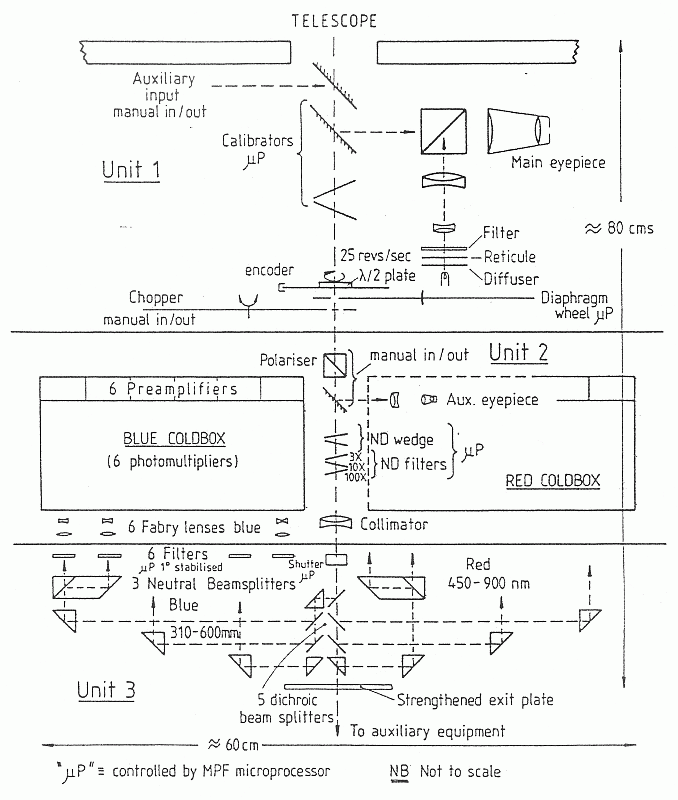 .
MPF is shown schematically in Figure
.
MPF is shown schematically in Figure  .
.




MPF's prime field of application is precision multi-channel work on brighter stars, the limit of what is ``bright'' depending on the bandwidth. ND filters provide it with high dynamic range. Dichroic beam-splitters make it possible to observe in up to 12 channels simultaneously. In addition to being an efficient use of the available light, this allows cancellation of extinction and scintillation noise in many applications. The MPF has a wide spectral range, from about 360 to about 870 nm.
A Users' Manual and a Manual of Exchangeable Optics are available. The
latter contains details of filters and beamsplitters available.
An overview is given in Table  .
MPF is shown schematically in Figure
.
MPF is shown schematically in Figure  .
.

[ TIFF ]
Figure: The Multi-Purpose Fotometer
The dark current of the photomultiplier tubes in MPF varies from tube to tube, and is normally between 30 and 200 counts per second, though it may be as high as 1000 counts per second in the summer, when ambient temperatures are around 15 C. The dark current noise is about the same for both red and blue photomultipliers, so that the red and blue channels are well matched. A rough estimate of the limiting magnitude for dark current limited applications can be obtained by assuming a norm for the dark current of 100 counts per second, a total beamsplitting efficiency of 40% , and a detector efficiency of 15%. For a 10 second integration, a signal to noise ratio of about 30 will be obtained on the JKT for stars of the following magnitudes:

Since, with a 10 arcsec diaphragm, even a dark sky is of magnitude 15, many wider-band observations will be limited by sky background rather than dark current and the limiting magnitude should be estimated on the basis of expected sky conditions (including the likelihood of dust). There is no bright limit in night-time observations: the ND filters can handle Jupiter and the moon.
The linear polarisation modulation exceeds 98% over the whole wavelength range and if one is interested in wide spectral coverage of polarisation, then MPF is currently the best instrument to use. MPF does lose 50% of the light in the analysing polariser compared to PP, so only comes into its own when observations in many bands are required. Polarisation zero-point instabilities, which are as yet imperfectly understood, can be kept below 0.05% by careful (re)centering
A mode only available in MPF is multi-line-index photometry with high precision. This mode combines the freedom from slow drifts of the single-channel line photometer with the freedom from extinction/scintillation noise of the two-channel line photometer, and all of this in up to 6 lines simultaneously. This technique holds great promise for work with the stronger absorption lines, supporting precise, efficient line photometry when large format CCDs become available. Due to its ND filters, MPF can calibrate these indices on the very brightest stars, while applying them to the much fainter ones in the CCD fields. The limiting precision of this mode has not yet been determined; it is certainly better than 0.001 magnitudes in the line index.



